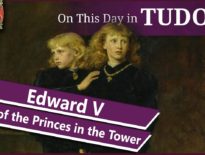On this day in Tudor history, 1st November 1527, the feast of All Saints, William Brooke, 10th Baron Cobham, courtier and diplomat, was born.
Cobham was a close friend of William Cecil, Baron Burghley and Elizabeth’s I’s chief advisor, so Cobham became powerful in Elizabeth's reign, serving her in a number of important offices. And, this baron was able to escape charges of treason twice thanks to the influence of his friends and patrons.
Find out more about Cobham's life, career, and brushes with trouble, which included links with Wyatt's Rebellion and the Ridolfi Plot, in today's talk.
Also on this day in Tudor history, 1st November 1456, Edmund Tudor, 1st Earl of Richmond and father of King Henry VII, died from the plague at Carmarthen Castle in Wales. Edmund never knew his son because he died while his wife, Lady Margaret Beaufort, was pregnant. You can find out more about Edmund and how he ended up dying at Carmarthen, in last year’s video:
Also on this day in history:
- 1530 – Henry VIII sent Sir Walter Walsh (some say William Walsh) with Henry Percy, Earl of Northumberland, to Cawood Castle to arrest Cardinal Thomas Wolsey for high treason. They arrived on 4th November and took him into custody.
- 1558 – Death of Michael Throckmorton, agent for Cardinal Reginald Pole, probably at Mantua in Italy. He studied law in Italy, in Padua, in 1533 before becoming Pole's secretary. It is thought that he may well have been the agent who took Pole's Pro ecclesiasticae unitatis defensione to Henry VIII in 1536.
Transcript:
On this day in Tudor history, 1st November 1527, the feast of All Saints, William Brooke, 10th Baron Cobham, courtier and diplomat, was born.
Cobham was a close friend of William Cecil, Baron Burghley and Elizabeth’s I’s chief advisor, so Cobham became powerful in Elizabeth’s reign. He served as Lord Warden of the Cinque Ports, Privy Councillor and Lord Chamberlain, and was able to escape charges of treason twice, thanks to his friends and patrons.
Let me tell you a bit more about this Tudor man…
• William was born in 1527 and was the eldest surviving son of George Brooke, 9th Baron Cobham, and his wife, Anne Bray.
• Although he was officially enrolled at Queen’s College, Cambridge, in the early 1540s, it appears that William was in Padua and Venice, where he was supposed to be studying civil law, although, as his biographer Julian Lock points out, he was licensed to carry arms and so might have been more interested in being a soldier.
• When he was just eight years old, he was contracted to marry Dorothy Neville, daughter of George Neville, 3rd Baron Abergavenny, and the couple married in 1545. The marriage was an unhappy one, but they had a daughter, Frances, together before separating in around 1553. Dorothy died in 1559.
• In the late 1540s, William was serving as a soldier at the garrisons in Boulogne, then Calais, and he was knighted in December 1548.
• In 1549, he had his first experience of diplomacy, accompanying Sir William Paget on an embassy to Brussels.
• He served King Edward VI as an esquire of the body and in 1550 the leader of Edward’s government, John Dudley, Duke of Northumberland, appointed William to the privy council. In 1551, he accompanied William Parr, Marquess of Northampton, who was married to his sister, Elizabeth, on an embassy to France.
• In 1553, William was able to avoid being caught up in the Lady Jane Grey succession crisis, by abandoning Northumberland, but he was sympathetic to the rebel cause in the early 1554 Wyatt’s Rebellion. His father’s home, Cooling Castle, was besieged by the rebels in January 1554 and William’s father, who was Wyatt’s uncle, claimed he had fought valiantly against the rebels for seven hours before surrendering to them. However, his resistance is more likely to have been a pretence and he and his sons joined the rebels willingly. William and his brother, George, were able to escape being tried as traitors thanks to the intervention of William’s brother-in-law, Henry Nevill, 6th Baron Bergavenny – phew!
• William’s father died in September 1558 and he inherited the title of Baron Cobham. Then, in November 1558, Elizabeth I came to the throne and William was made a special ambassador for the mission of taking the news of Mary I’s death to her husband Philip II of Spain.
• In December 1558, thanks to his friendship with William Cecil, William was made Lord Warden of the Cinque Ports and Constable of Dover Castle, and then, in 1559 he was made Lord Lieutenant and Vice Admiral of Kent. He also served as a justice of the peace for the county.
• In 1560, William married Frances Newton, daughter of Sir John Newton and Margaret Poyntz, and a woman who was serving Elizabeth I in her privy chamber. The marriage was a happy one and the couple went on to have 7 children together, 4 sons and 3 daughters.
• In 1571, William seized letters from Roberto di Ridolfi, who is known for the Ridolfi Plot against Elizabeth I, but according to William, his brother, Thomas, persuaded him not to turn them over to the privy council for fear that he and their friend, the Duke of Norfolk, would get into trouble. The fact that William didn’t get into big trouble suggests either that William was actually acting under instructions from Burghley and letting the plot play out, or that Burghley realised that William was not involved in the plot in any way. His punishment was seven months of house arrest in the custody of Burghley.
• In 1578, he was back working for the government, accompanying Sir Francis Walsingham on an embassy to the Netherlands.
• Although William was friends with Catholics like the Duke of Norfolk and the Earl of Arundel, and his wife, Frances, was a Catholic, Calvinist works were dedicated to him and his chaplain was Protestant. He was also given the job of helping John Whitgift, Archbishop of Canterbury, investigate the Marprelate Tracts in 1588.
• In 1585, William was installed as a Knight of the Garter and by early 1586 he was serving on Elizabeth I’s privy council.
• In 1588, he wasn’t involved in the Spanish Armada in his office at Dover because he was on a diplomatic mission to the Duke of Parma.
• In 1589, William’s daughter, Elizabeth, married Robert Cecil, bringing William even closer to the Cecils.
• In 1592, William’s wife died at their home Cobham Hall.
• In 1596, William was made Lord Chamberlain following the death of Baron Hunsdon, but in the winter of 1596 and 7 his health began to suffer. He died on 6th March 1597, just over a month after his daughter, Elizabeth, and was buried at St Mary Magdelene Church, Cobham. In his will he left money for the dissolved Cobham Chantry to become Cobham College almshouse. His eldest son, Maximilian, had died in 1583, so his second son, Henry, inherited his title, becoming 11th Baron Cobham.
It’s amazing how William kept favour and kept his head, and he really benefited from having friends in high places.




Leave a Reply